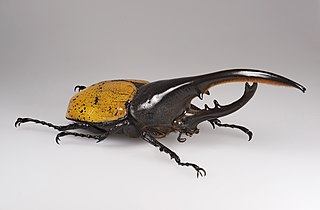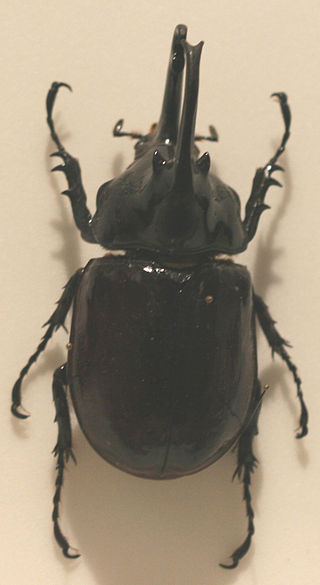
Tiger beetles are a family of beetles, Cicindelidae, known for their aggressive predatory habits and running speed. The fastest known species of tiger beetle, Rivacindela hudsoni, can run at a speed of 9 km/h, or about 125 body lengths per second. As of 2005, about 2,600 species and subspecies were known, with the richest diversity in the Oriental (Indo-Malayan) region, followed by the Neotropics. While historically treated as a subfamily of ground beetles (Carabidae) under the name Cicindelinae, several studies since 2020 indicated that they should be treated as a family, the Cicindelidae, which are a sister group to Carabidae within the Adephaga.

Ground beetles are a large, cosmopolitan family of beetles, the Carabidae, with more than 40,000 species worldwide, around 2,000 of which are found in North America and 2,700 in Europe. As of 2015, it is one of the 10 most species-rich animal families. They belong to the Adephaga. Members of the family are primarily carnivorous, but some members are phytophagous or omnivorous.

Passalidae is a family of beetles known variously as "bessbugs", "bess beetles", "betsy beetles" or "horned passalus beetles". Nearly all of the 500-odd species are tropical; species found in North America are notable for their size, ranging from 20–43 mm, for having a single "horn" on the head, and for a form of social behavior unusual among beetles.
The false stag beetles (Diphyllostoma) are a group of three species of rare beetles known only from California. Almost nothing is known of their life history beyond that the adults are diurnal and females are flightless; larvae have not been observed.

Lutrochidae is a family of water beetles with a single genus Lutrochus sometimes known as "travertine beetles". There are around 21 species native to the Americas from the southern United States to Brazil.

Glaresis is a genus of beetles, sometimes called "Enigmatic scarab beetles", in its own family, the Glaresidae. It is closely related to, and was formerly included in, the family Scarabaeidae. Although its members occur in arid and sandy areas worldwide, only the nocturnal adults have ever been collected, and both the larvae and biology of Glaresis are as yet unknown. Due to their narrow habitat associations, a great number of these species occur in extremely limited geographic areas, and are accordingly imperiled by habitat destruction.

Trogidae, sometimes called hide beetles, is a family of beetles with a distinctive warty or bumpy appearance. Found worldwide, the family includes about 300 species contained in four or five genera.

Dermestidae are a family of Coleoptera that are commonly referred to as skin beetles. Other common names include larder beetle, hide or leather beetles, carpet beetles, and khapra beetles. There are over 1,100 species described.

The Hercules beetle is a species of rhinoceros beetle native to the rainforests of Central America, South America, and the Lesser Antilles. It is the longest extant species of beetle in the world, and is also one of the largest flying insects in the world.

Derodontidae is a family of beetles, in its own superfamily, Derodontoidea, sometimes known as the tooth-necked fungus beetles. Beetles of this family are small, between 2 and 6 mm in length, typically with spiny margins on their pronotum that give them their name, though the genus Laricobius lacks these spines. Unusual among beetles, they have two ocelli on the top of their heads.

Heteroceridae, the variegated mud-loving beetles, are a widespread and relatively common family of beetles found on every continent except for Antarctica.

Phyllobates is a genus of poison dart frogs native to Central and South America, from Nicaragua to Colombia. There are 3 different Colombian species of Phyllobates, considered highly toxic species due to the poison they contain in the wild.

The Celyphidae, commonly known as beetle flies or beetle-backed flies, are a family of flies. About 115 species in about 9 genera are known chiefly from the Oriental and Afrotropic biogeographic regions with one lineage in the New World.

Augosoma centaurus, the centaurus beetle, is a species of rhinoceros beetle found in tropical Africa, which measures about 40–90 mm. As common in many insect species, the male is larger than the female and usually two males will fight for a female for mating.

Eretes is a genus of beetles in the family Dytiscidae. The genus is native to the Afro-tropical region, the Palearctic, the Near East, North Africa and the Asian region.

Jacobsoniidae are a family of tiny beetles belonging to Staphylinoidea. The larvae and adults live under bark, in plant litter, fungi, bat guano and rotten wood. There are around 28 described species in three genera:

Mitrastemon is a genus of two widely disjunct species of parasitic plants. It is the only genus within the family Mitrastemonaceae. Mitrastemon species are root endoparasites, which grow on Fagaceae. It is also a non-photosynthetic plant that parasitizes other plants such as Castanopsis sieboldii. The parasitic plant was first discovered by botanist Eizi Matuda during an expedition to Mt. Ovand in the state of Chiapas, Mexico. The different species were originally named by a friend of Matuda, Yamamoto in 1925–1926. Mitrastemon yamamotoi is a protandrous plant. Its flowers go through a male phase before transforming into their final female form. The flowers of M. yamamotoi attract a variety of insects ranging from wasps to flies and beetles. Among these, beetles are the best pollinators for this plant since their visit to the flower would pick up a large amount of pollen and they would pollinate from each of the flowers that they had already visited. The plant is endemic to tropical and subtropical forest regions such as Southeast Asia and Japan.

Laemostenus janthinus is a species of ground beetle in the subfamily of Harpalinae.

Laemostenus complanatus is a species of ground beetle native to Europe.
Grotta dell'Artiglieria is a Karst cave in the municipality of Doberdò del Lago. The cave is located NE of Doberdob Lake, near the top of a small hill, in the small village of Jamiano. The name is referred to the artillery battery set in the cave during World War I.


















